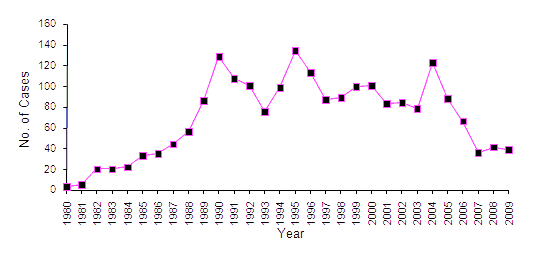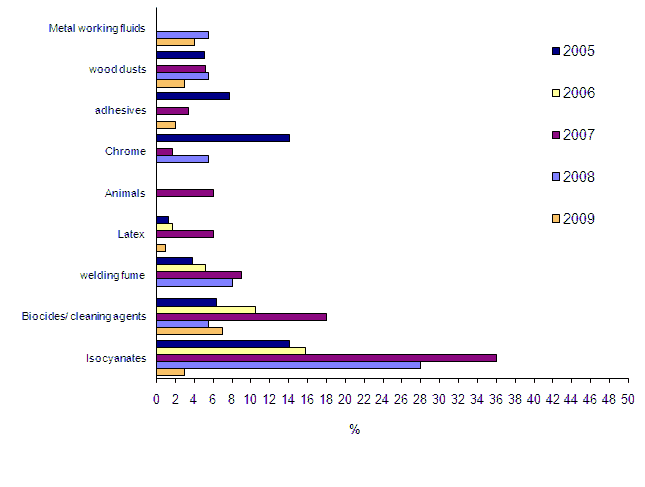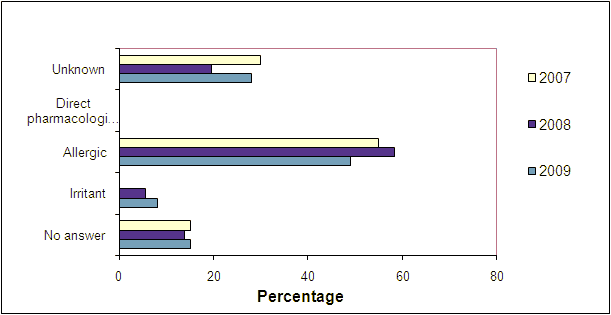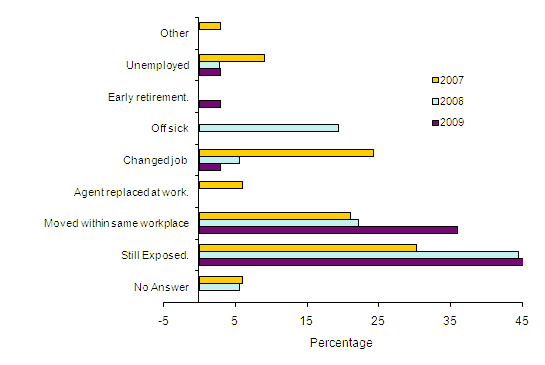Shield Report 2009, 39 New cases in this Shield report, most common causative agent was Cleaning agents (18%) |

|
C Burge, VC Moore, AS Robertson, AD Vellore and PS Burge.
Occupational Lung Disease Unit, Heartlands Hospital, Bordesley Green East, Birmingham B9 5SS
SHIELD is the Midland Thoracic Society’s Surveillance Scheme for
Occupational Asthma for the West Midlands. The scheme, which was set up
in January 1989, was established to study the general and specific
incidence of occupational asthma within the West Midlands region and
Metropolitan County. The rate of reporting increased sharply in 2004,
mainly due to a major outbreak, but since then we have seen a steady
decrease in reports with 2009 having 39 reports. We believe this is likely to be short lived however, with
reports rising soon.
The most common cause in 2009 was Cleaning and sterilising agents (18%). Metal working fluids came second at 10%. There was only one report of Latex, suggesting that
substitution of latex gloves is continuing.
85% of cases reported in 2009 were by the Birmingham Chest Clinic
and 3% by others. We hope to increase the number notified by others
this year by using the MTS website to contact notifiers. The most common method
for the diagnosis of occupational asthma still remains a history of
improvement of symptoms during holidays or periods off work. Some form
of objective confirmation was sought in 94% of patients showing
improvement away from work.
We
still have plans for developing the Shield Database. This may be with
web based reporting or in conjunction with a new version of Oasys to be
used via the internet. There are higher
priorities on the agenda and the plans remain in limbo at the moment.
Introduction
Shield is a joint project between the West Midlands branch of the
Society of Occupational Medicine and the Midland Thoracic Society. The
scheme, which was set up in January 1989, was established to meet three
main objectives. 1) To study the general and specific incidence of
occupational asthma within a defined geographic area, 2) To determine
proposed mechanisms of asthma, and 3) to audit diagnostic methods and
objectives. Chest physicians and members of the West Midlands Group of
the Society of Occupational Medicine implemented the scheme, by
reporting each new case using a questionnaire format. The questionnaire
covers confidential personal information on the patient, details of the
diagnosis, information about their occupational history, and the
outcome after diagnosis.
The last report on Shields progress was written in 2008 and
summarised the information gained in that year, to that of previous
years, 2007 and 2006. This report aims to update the participants of
Shield by summarising the trends found in 2009 compared to those found
in 2008 and 2007.
Outbreak of the year
We have seen 5 workers from a factory machining high chrome and nickel steel alloys for the aerospace industry. 4 have positive peak flows and 3 have positive specific challenges to chrome and 1 to cobalt. Cobalt is a recognised contaminant of metal working fluid when hard metal tipped tools are used but chrome has not previously been described as a cause of occupational asthma from metal working fluid (but is a well recognised cause of occupational asthma in welders, electroplaters and refiners).
Agent Awareness
We've seen several workers with a good history of occupational asthma and positive peak flow records whose only obvious exposure is to diesel exhaust particulates. Several worked in bus garages and others in warehouses where diesel engine lorries backed into the loading bays. Diesel exhaust particulates absorb allergens and other materials and provide a method for inhaling ultrafines. Diesel exhaust particulates have previously been shown to enhance allergic reactions, but not necessarily to be the sole cause.
The control of diesel exhaust in bus garages is not straightforward, particularly when buses are being run on rolling roads during testing which involves analysis of exhaust gases, during which local exhaust extraction cannot be used.
Shield Data
Number of Cases
The number of cases of occupational asthma reported to the Shield
scheme is 39 so far. When the SHIELD report for 2008 was written, there
were 36 cases notified, but now this figure is up to 41. It is
difficult to compare notification for each year properly, as the last
few years are likely to change, therefore the graph below is only as a
guideline.
Figure 1 Number of cases diagnosed with occupational asthma between the years of 1980 and 2009

Personal details
In the year of 2009, 39 new cases have been reported to the scheme
so far. There were 27 males (69%), and 9 females (23%). 31 (79%) of
the new cases had no pre-existing asthma, and 21 (54%) had never smoked.
Reporting Hospital and Physician
The Shield scheme is confined to the West Midlands Region and the
West Midlands Metropolitan County. In this region there are many chest
physicians, hospitals, clinics and other organisations, which are known
to the Shield scheme. However, many of these have not been asked to
report over the last year due to the data protection issues. Therefore,
in 2009, 33 (85%) of the cases reported to Shield were through the
Birmingham Chest Clinic, and 1 (3%) through other organisations. We are
hoping that there will be more cases reported from other institutions
in the coming year.
Suspected agents at work
In 2009 the most common reported agent that workers were exposed to
was cleaning and sterilising agents (18%). The 2 most common in 2008 were isocyanates and welding fumes (28% and 8% respectively). Isocyanates were
also the most common in
2007. 450 cases of isocyanate
suspected asthma have now been reported to the scheme, the first case
being in 1978. Metal exposed cases are low and stable with only 4
notifications being made in 2009.
The top six agents reported in 2009 were;
- Cleaning and sterilising agents 18% 7 cases
- Metal working fluids 10% 4 cases
- Wood dusts 8% 3 cases
- Isocyanates 8% 3 cases
- Glues 5% 2 cases
- Diesel Fumes 5% 2 cases
Figure 2 Comparison of the percentage of patients exposed to the top five agents in 2009 to those exposed in 2008-2005.

Employers and Jobs
There were 35 different employers reported to the scheme in 2009.
Around 35 different jobs were reported in 2009, although it would be
possible to group some of the specific jobs into broader categories
(e.g. nurses).
Table 1 A list of the most common agents reported in 2009 with the corresponding jobs
| Agent Exposed |
Job |
Cleaning / sterilising agents
|
Health professional, lab worker, cleaner, hairdresser, manager
|
Metal working fluids
|
Grinder, Cutter, Manager
|
Wood dusts
|
Teacher, polisher, workshop technician
|
Isocyanates
|
Paint sprayer, chemist, fitter
|
Diesel fumes
|
warehouse workers, railway engineers
|
Methods used for diagnosis
The methods used for diagnosis that are documented on the shield
form are; 1) Improvement on holiday, 2) Improvement off work, 3) Serial
peak flow charts, 4) Specific IgE, 5) Methacholine at work, and 6)
Methacholine away from work and 7) Specific bronchial provocation
tests. 32 cases were documented as improving off work and 33 on holidays.
Of these, 29 cases had at least one other investigation. The most
common investigation was serial peak flow charts (32 cases). There were 10 specific challenges performed on patients diagnosed in 2009.
Table 2 Percentage use of each method of diagnosing occupational asthma in 2009, 2008 and 2007.
| Method |
% 2009
|
% 2008 |
% 2007 |
| Improving on holidays |
85 |
92
|
91 |
| Improving off work |
82 |
89
|
85 |
| Serial peak flow |
82 |
81
|
70
|
| Specific IgE |
41 |
53
|
45
|
| Methacholine at work |
59 |
58
|
39
|
| Methacholine away from work |
18 |
31
|
33
|
Specific Bronchial Challenge
(positive challenges) |
10 (1) |
8 (2)
|
15 (6) |
Proposed method of asthma
Figure 3 shows the proposed mechanism of asthma in patients with
diagnosed occupational asthma in 2009, 2008 and 2007. In 2009 the most
commonly reported mechanisms of asthma were allergic (49 %) and unknown
(28 %). In 2008 allergic and unknown mechanisms were also reported in
most cases (58% and 19% respectively). The percentage of ‘no answer’
remains similar in 2009 at 15% (14% in 2008) The other mechanisms (irritant and direct
pharmacological effect) have hardly been used this year.
Figure 3 Proposed mechanisms of asthma in 2009, 2008 and 2007

Subsequent History
The subsequent history of the patients diagnosed with occupational
asthma in 2009 is shown in Figure 4. There are a similar amount of
workers remaining exposed, more have been relocated within the same workplace (which we think is usually the best outcome). The number off sick and the amount that have changed job has fallen. The
recorded subsequent history of the patient is taken at diagnosis and is
subject to change so these figures will change with time.
Figure 4 Subsequent history of patients diagnosed of occupational asthma in 2009, 2008 and 2007

Gold Standards
A gold standard occupational asthma case is defined by either; 1)
Bronchial challenge test, 2) A four fold change in their bronchial
reactivity with a good history, or 3) Positive IgE with a good history,
and all of these can be accompanied by a good quality PEF record. 13%
of cases have become gold standards in 2009 so far.
Future Developments
The Oasys program has been developed to
work through the internet. The program saves all anonymous data from records entered with Oasys to this website. We hope that people will use this program and that we will be able to usefully disseminate this anonymous information for Shield Reports. If this goes ahead it will increase the geographical scope of Shield worldwide and probably increase notification by a very large factor. However the quality of data will probably decline as we will have no control over notifiers to the scheme and it is likely that not everyone will enter the data with as much enthusiasm as we do. The audit recommendations from the BTS Standards of care for occupational asthma (Fishwick D et al. Standards of care for occupational asthma,
Thorax, 2008; 63 : 240-250) can also be collected through Oasys.
Conclusions
Occupational asthma remains a serious disease causing much
morbidity, and is potentially preventable. The Health and Safety
Executive are currently emphasising the need to control occupational
asthma.
References
Comments
Please sign in or register to add your thoughts.